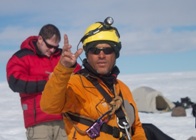On thin ice

Dr Hubbard preparing to film a sequence that appears in the final part of the Frozen Planet series.
06 December 2011
The final edition sees series presenter David Attenborough meet up with Dr Hubbard on the Greenland ice-shelf as he journeys to both Poles to investigate what rising temperatures will mean for the people and wildlife that live there and for the rest of the planet.
Dr Hubbard, a researcher at the University’s Institute of Geography and Earth Sciences, worked closely with the Frozen Planet production team on all aspects of the Greenland shoots.
During peak filming in July and August last year, Dr Hubbard and his research team from Aberystwyth and Swansea Universities hosted seven of the BBC Natural History crew for two weeks, as well as numerous journalists from Sky News, the New York Times and the Daily Mail at his Melt Lake Camp in the interior of the Greenland Ice Sheet.
Dr Hubbard also closely directed and assisted the BBC camera team at another of his Greenland research sites, Store Glacier, where the spectacular calving iceberg footage shown in Episode 1 (and seen again in the forthcoming episode) was filmed.
Since 2008, Dr Hubbard has been advising and aiding the Frozen Planet producers on the many scientific and logistical issues of filming in such a remote and hostile region as Greenland, including the provision of AS350 helicopters (& pilots) from which all the stunning cineflex aerial filming was shot and also providing the BBC with the ice research vessel - Gambo (featured in the last episode) – which supported operations from the sea.
Dr Hubbard said ‘Last summer was incredibly hard work and also very stressful at times, directing multiple crews and helicopters with ground, air and marine support along with managing work teams on the ice in difficult and dangerous locations. But everyone knew their job, and the whole caboodle came off just perfectly – a credit to all. It’s so satisfying now to sit back and enjoy the rewards of these efforts – the whole of the Frozen Planet series including our Greenland research looks stunning.’
Petermann Glacier retreat
During the summer of 2011 Dr Hubbard published dramatic images that revealed the extent to which Greenland’s largest outlet - Petermann Glacier - has retreated 20km in just two years.
The images, taken by Dr Hubbard on the same July date in 2009 and 2011 show the 300 km Petermann Glacier, which accounts for 6% of the area of the Greenland Ice Sheet, before and after a huge iceberg measuring over 200km2 became detached in August 2010.
At the time, Dr Hubbard described the change as “gob-smacking”. He said “It was incredible to see. This glacier is huge, 20km wide and over 600m thick & hemmed in by sheer cliffs that rise to 1000m on either side. It’s like looking into the Grand Canyon full of ice and coming back two years later to find it’s full of water.”
Dr Hubbard, whose work has been supported by the Natural Environment Research Council (UK), believes that the cracks and rifts in what remains of the ice shelf means it is also likely to break up at some point in the near future.
He has just published an article in the latest edition of the journal ‘Geology Today’ on the Petermann Breakup, the Times Atlas and the actual state of health of the Greenland Ice Sheet.
A native of Borth near Aberystwyth, Dr Hubbard joined the Institute of Geography and Earth Sciences at Aberystwyth University in April 2007.
New website dedicated to the Greenland Ice-sheet
Dr Alun Hubbard and colleagues at the Centre for Glaciology at Aberystwyth University have established a new website dedicated to the research they are undertaking on the Greenland Ice-sheet.
The site www.aber.ac.uk/greenland provides a fascinating introduction to the ice-sheet, the second largest ice mass on the planet which accounts for roughly 11% of the global ice surface area.
With stunning photography and moving images, the site provides a dramatic insight into life and work in this hostile environment and provides detailed information on the three principal areas where Dr Hubbard and his team are working, the Russell Glacier catchment near Kangerlussuaq, the Uummannaq region of West Greenland and the Peterman Glacier in the very far North West.



